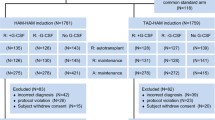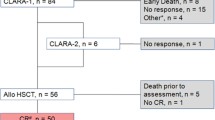Abstract
We evaluated a maintenance, post-remission treatment with low-dose chemotherapy plus differentiating agents on poor-prognosis acute myeloid leukemia (AML)/myelodysplastic syndrome (MDS) patients ineligible to allografting. Patients had either age over 60 and/or secondary AML, therapy-related AML, previous relapse, high-risk MDS. Forty-five patients received the maintenance therapy based on two alternated schedules: (a) 6-thioguanine + 13-cis retinoic acid + dihydroxylated vitamin D3 and (b) low-dose cytarabine + 6-mercaptopurine + all-trans retinoic acid + dihydroxylated vitamin D3. We compared their outcome, at a median follow-up of 52 months, to that of a matched population of 49 patients who stopped treatments after consolidation. Maintenance group had a lower relapse incidence (70.3 vs. 86.4 % at 5 years p = 0.007) and a longer disease-free survival (median 21.2 vs. 8.7 months, p = 0.017). The relapse reduction improved overall survival: median 40.4 months (35.9 % at 5 years) for maintenance group vs. 15.8 (14.2 % at 5 years) for controls (p = 0.005). At multivariate Cox analysis, both cytogenetic and maintenance therapies resulted independent outcome predictors for overall survival. Maintenance treatment also reduced minimal residual disease (detected by WT1 and CBFβ-MYH11) in five of eight evaluable patients. The present results suggest that our strategy of maintenance therapy might improve the outcome of poor-risk AML/MDS patients.





Similar content being viewed by others
References
Appelbaum FR, Gundacker H, Head DR et al (2006) Age and acute myeloid leukemia. Blood 107:3481–3485
Büchner T, Berdel WE, Haferlach C et al (2009) Age-related risk profile and chemotherapy dose response in acute myeloid leukemia: a study by the German Acute Myeloid Leukemia Cooperative Group. J Clin Oncol 27:61–69
Juliusson G, Antunovic P, Derolf A et al (2009) Age and acute myeloid leukemia: real world data on decision to treat and outcomes from the Swedish Acute Leukemia Registry. Blood 113:4179–4187
Bello C, Yu D, Komrokji RS et al (2011) Outcomes after induction chemotherapy in patients with acute myeloid leukemia arising from myelodysplastic syndrome. Cancer 117:1463–1469
Ruutu T, Hänninen A, Järventie G et al (1997) Intensive chemotherapy of poor prognosis myelodysplastic syndromes (MDS) and acute myeloid leukemia following MDS with idarubicin and cytarabine. Leuk Res 21:133–138
De Witte T, Suciu S, Peetermans M et al (1995) Intensive chemotherapy for poor prognosis myelodysplasia (MDS) and secondary acute myeloid leukemia (sAML) following MDS of more than 6 months duration. A pilot study by the Leukemia Cooperative Group of the European Organisation for Research and Treatment in Cancer (EORTC-LCG). Leukemia 9:1805–1811
Smith SM, Le Beau MM, Huo D et al (2003) Clinical-cytogenetic associations in 306 patients with therapy-related myelodysplasia and myeloid leukemia: the University of Chicago series. Blood 102:43–52
Kayser S, Döhner K, Krauter J et al (2011) The impact of therapy-related acute myeloid leukemia (AML) on outcome in 2853 adult patients with newly diagnosed AML. Blood 117:2137–2145
Godley LA, Larson RA (2008) Therapy-related myeloid leukemia. Semin Oncol 35:418–429
Wattel E, De Botton S, Luc Laï J et al (1997) Long-term follow-up of de novo myelodysplastic syndromes treated with intensive chemotherapy: incidence of long-term survivors and outcome of partial responders. Br J Haematol 98:983–991
Hast R, Hellström-Lindberg E, Ohm L et al (2003) No benefit from adding GM-CSF to induction chemotherapy in transforming myelodysplastic syndromes: better outcome in patients with less proliferative disease. Leukemia 17:1827–1833
Beran M, Shen Y, Kantarjian H et al (2001) High-dose chemotherapy in high-risk myelodysplastic syndrome: covariate-adjusted comparison of five regimens. Cancer 92:1999–2015
Fenaux P, Mufti GJ, Hellstrom-Lindberg E et al (2009) Efficacy of azacitidine compared with that of conventional care regimens in the treatment of higher-risk myelodysplastic syndromes: a randomised, open-label, phase iii study. Lancet Oncol 10:223–232
Bally C, Thépot S, Quesnel B et al (2013) Azacitidine in the treatment of therapy related myelodysplastic syndrome and acute myeloid leukemia (tMDS/AML): a report on 54 patients by the Groupe Francophone des Myelodysplasies (GFM). Leuk Res 37:637–640
Ganetsky A (2012) The role of decitabine for the treatment of acute myeloid leukemia. Ann Pharmacother 46:1511–1517
Joeckel TE, Lübbert M (2012) Clinical results with the DNA hypomethylating agent 5-aza-2’-deoxycytidine (decitabine) in patients with myelodysplastic syndromes: an update. Semin Hematol 49:330–341
Grimwade D (2001) The predictive value of hierarchical cytogenetic classification in older adults with acute myeloid leukemia (AML): analysis of 1065 patients entered into the United Kingdom Medical Research Council AML11 trial. Blood 98:1312–1320
Rossi G, Pelizzari AM, Bellotti D et al (2000) Cytogenetic analogy between myelodysplastic syndrome and acute myeloid leukemia of elderly patients. Leukemia 14:636–641
Seedhouse C, Russell N (2007) Advances in the understanding of susceptibility to treatment-related acute myeloid leukaemia. Br J Haematol 137:513–529
Kantarjian HM, Estey EH, Keating MJ (1993) Treatment of therapy-related leukemia and myelodysplastic syndrome. Hematol Oncol Clin N Am 7:81–107
Kern W, Haferlach T, Schnittger S et al (2004) Prognosis in therapy-related acute myeloid leukemia and impact of karyotype. J Clin Oncol 22:2510–2511
Krug U, Lübbert M, Büchner T (2010) Maintenance therapy in acute myeloid leukemia revisited: will new agents rekindle an old interest? Curr Opin Hematol 17:85–90
Büchner T, Urbanitz D, Hiddemann W et al (1985) Intensified induction and consolidation with or without maintenance chemotherapy for acute myeloid leukemia (AML): two multicenter studies of the German AML Cooperative Group. J Clin Oncol 3:1583–1589
Löwenberg B, Suciu S, Archimbaud E et al (1998) Mitoxantrone versus daunorubicin in induction-consolidation chemotherapy—the value of low-dose cytarabine for maintenance of remission, and an assessment of prognostic factors in acute myeloid leukemia in the elderly: final report. European Organization for the Research and Treatment of Cancer and the Dutch-Belgian Hemato-Oncology Cooperative Hovon Group. J Clin Oncol 16:872–881
Buchner T, Hiddemann W, Wormann B et al (1999) Double induction strategy for acute myeloid leukemia: the effect of high-dose cytarabine with mitoxantrone instead of standard-dose cytarabine with daunorubicin and 6-thioguanine: a randomized trial by the German AML Cooperative Group. Blood 93:4116–4124
Robles C, Kim KM, Oken MM et al (2000) Low-dose cytarabine maintenance therapy vs observation after remission induction in advanced acute myeloid leukemia: an Eastern Cooperative Oncology Group Trial (E5483). Leukemia 14:1349–1353
Büchner T, Hiddemann W, Berdel WE et al (2003) 6-thioguanine, cytarabine, and daunorubicin (TAD) and high-dose cytarabine and mitoxantrone (HAM) for induction, TAD for consolidation, and either prolonged maintenance by reduced monthly TAD or TAD-HAM-TAD and one course of intensive consolidation by sequential HAM in adult patients at all ages with de novo acute myeloid leukemia (AML): a randomized trial of the German AML Cooperative Group. J Clin Oncol 21:4496–4504
Büchner T, Berdel WE, Schoch C et al (2006) Double induction containing either two courses or one course of high-dose cytarabine plus mitoxantrone and postremission therapy by either autologous stem-cell transplantation or by prolonged maintenance for acute myeloid leukemia. J Clin Oncol 24:2480–2489
Rai KR, Holland JF, Glidewell OJ et al (1981) Treatment of acute myelocytic leukemia: a study by cancer and leukemia group B. Blood 58:1203–1212
Sanz MA, Grimwade D, Tallman MS et al (2009) Management of acute promyelocytic leukemia: recommendations from an expert panel on behalf of the European Leukemia Net. Blood 113:1875–1891
Altucci L, Rossin A, Hirsch O et al (2005) Rexinoid-triggered differentiation and tumor-selective apoptosis of acute myeloid leukemia by protein kinase A-mediated desubordination of retinoid X receptor. Cancer Res 65:8754–8765
Schenk T, Chen WC, Göllner S et al (2012) Inhibition of the LSD1 (KDM1A) demethylase reactivates the all-trans-retinoic acid differentiation pathway in acute myeloid leukemia. Nat Med 18:605–611
Morosetti R, Koeffler HP (1996) Differentiation therapy in myelodysplastic syndromes. Semin Hematol 33:236–245
Ferrero D, Carlesso N, Bresso P et al (1997) Suppression of in vitro maintenance of non-promyelocytic myeloid leukemia clonogenic cells by all-trans retinoic acid: modulating effects of dihydroxylated vitamin D3, alpha interferon and “stem cell factor”. Leuk Res 21:51–58
Ferrero D, Carlesso N, Pregno P et al (1992) Self-renewal inhibition of acute myeloid leukemia clonogenic cells by biological inducers of differentiation. Leukemia 6:100–106
Waxman S (2000) Differentiation therapy in acute myelogenous leukemia (non-APL). Leukemia 14:491–496
Bruserud O, Gjertsen BT (2000) New strategies for the treatment of acute myelogenous leukemia: differentiation induction—present use and future possibilities. Stem Cells 18:157–165
Schlenk RF, Fröhling S, Hartmann F et al (2004) Phase III study of all-trans retinoic acid in previously untreated patients 61 years or older with acute myeloid leukemia. Leukemia 18:1798–1803
Venditti A, Tamburini A, Buccisano F et al (2000) A phase-II trial of all trans retinoic acid and low-dose cytosine arabinoside for the treatment of high-risk myelodysplastic syndromes. Ann Hematol 79:138–142
Ferrero D, Bruno B, Pregno P et al (1996) Combined differentiating therapy for myelodysplastic syndromes: a phase II study. Leuk Res 20:867–876
Ferrero D, Foli C, Campa E, Pileri A (1999) A combination of 13-cis retinoic acid + dihydroxylated vitamin d3 +/- low-dose chemotherapy as a treatment for myelodysplastic syndromes (abstract). Blood 94:307a
Ferrero D, Campa E, Dellacasa C et al (2004) Differentiating agents + low-dose chemotherapy in the management of old/poor prognosis patients with acute myeloid leukemia or myelodysplastic syndrome. Haematologica 89:619–620
Greenberg P, Cox C, LeBeau MM et al (1997) International scoring system for evaluating prognosis in myelodysplastic syndromes. Blood 89:2079–2088
Grimwade D (2012) The changing paradigm of prognostic factors in acute myeloid leukaemia. Best Pract Res Clin Haematol 25:419–425
Cilloni D, Renneville A, Hermitte F et al (2009) Real-time quantitative polymerase chain reaction detection of minimal residual disease by standardized WT1 assay to enhance risk stratification in acute myeloid leukemia: a European Leukemia Net study. J Clin Oncol 27:5195–5201
Van Dongen JJ, Macintyre EA, Gabert JA et al (1999) Standardized RT-PCR analysis of fusion gene transcripts from chromosome aberrations in acute leukemia for detection of minimal residual disease. Report of the BIOMED-1 concerted action: investigation of minimal residual disease in acute leukemia. Leukemia 13:1901–1928
Gabert J, Beillard E, van der Velden VHJ et al (2003) Standardization and quality control studies of “real-time” quantitative reverse transcriptase polymerase chain reaction of fusion gene transcripts for residual disease detection in leukemia—a Europe Against Cancer program. Leukemia 17:2318–2357
Beillard E, Pallisgaard N, van der Velden VHJ et al (2003) Evaluation of candidate control genes for diagnosis and residual disease detection in leukemic patients using “real-time” quantitative reverse-transcriptase polymerase chain reaction (RQ-PCR)—a Europe Against Cancer program. Leukemia 17:2474–2486
Boumber Y, Kantarjian H, Jorgensen J et al (2012) A randomized study of decitabine versus conventional care for maintenance therapy in patients with acute myeloid leukemia in complete remission. Leukemia 26:2428–2431
Conflict of interest
The authors have no conflict of interest to disclose.
Author contributions
DF designed the study, treated patients and wrote the paper; EC collected and analyzed data,treated patients and wrote the paper;* FM, EA, CF, VG, BB treated patients and reviewed the paper; TG e MF collected data; TG also helped in manuscript preparation; RP performed statistical analysis; LR performed molecular analysis; MB and BB supervised the research and provided funds.
Author information
Authors and Affiliations
Corresponding author
Additional information
Dario Ferrero and Elena Crisà equally contributed to the clinical study and to paper preparation.
Rights and permissions
About this article
Cite this article
Ferrero, D., Crisà, E., Marmont, F. et al. Survival improvement of poor-prognosis AML/MDS patients by maintenance treatment with low-dose chemotherapy and differentiating agents. Ann Hematol 93, 1391–1400 (2014). https://doi.org/10.1007/s00277-014-2047-7
Received:
Accepted:
Published:
Issue Date:
DOI: https://doi.org/10.1007/s00277-014-2047-7




